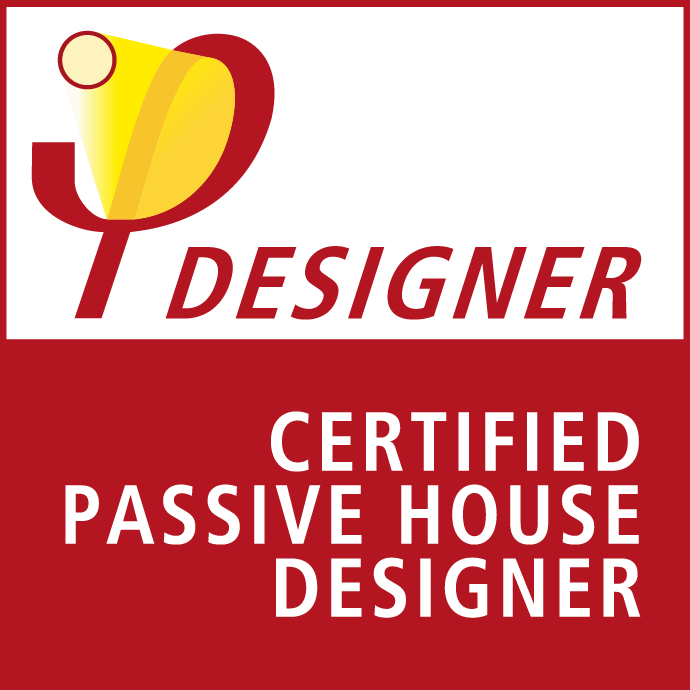
Passive House
Passive House is an affordable design and construction standard for buildings (not just houses!) that prioritizes superior energy efficiency, indoor air quality, occupant health and comfort and durable construction, while dramatically reduces a building’s carbon emissions. Essentially Passive House is building science that is good for the environment, good for the occupants and ultimately makes sense economically. Win-win-win!
How does it work?
Thoughtful detailing and construction while utilizing high-performance windows and doors allows the building to use minimal “active” heating and cooling for year-round comfort. This means much lower utility bills! Centralized, continuous ventilation with heat recovery maintains the indoor temperature while supplying filtered, fresh outdoor air when the windows are closed. This means all rooms are comfortable and draft-free, with healthy, fresh indoor air. Passive House buildings are much tighter construction which allows for fantastic energy efficiency and health of the building and its occupants. This approach coupled with efficient lighting, appliances and equipment means the building can operate with very little energy while providing the highest level of occupant comfort and air-quality for better health.
More resilient to wildfire
When wildfire or fire from a nearby structure occurs the embers from the fire are what typically allow the fire to spread so rapidly from one building to the next. In traditional construction with many vents at the roof eaves and penetrations through the walls and roof, the embers can easily be sucked into the attic space and start to burn the home from within. The tightness of passive house design makes it less likely for those embers to enter the home. This has been proven in recent fire disasters where the home constructed with passive house detailing is the only one standing amidst a sea of ash by the neighboring properties. See news feature here.
Can you open the windows in a Passive House?
Absolutely! Passive cooling and ventilation from windows is perfect for times when the outside air is cool and not humid, and when outdoor air quality is not an issue.
What’s the difference between a Passive House and more traditional methods of building?
Many traditionally constructed buildings are very “leaky” and “drafty”, meaning the air you have paid to heat or cool goes right through the exterior walls and windows. The “leakiness” can also allow outdoor allergens, pollutants and noise to enter the building which is not good for occupant health or comfort. Furthermore, many traditionally built buildings are highly conducive to condensation inside the walls which can lead to mold growth – definitely not good for occupant health or for the longevity of the building!
Renewable energy-friendly
Because a Passive House uses so little energy, most are well-suited to utilizing renewable energy such a solar for the lights, equipment and car charging, so the building can be much less reliant on the grid.
What about Net-Zero?
Did you know that buildings worldwide account for 37% of global carbon emissions and 34% of energy demand? Net-Zero is about balancing greenhouse gasses going into the atmosphere with those being removed from the atmosphere – Ideally getting to “net-zero” or better yet, carbon positive (making additional “positive” contributions to the environment). Passive House is a pathway to Net-Zero by using fewer resources. Passive House goes beyond reducing carbon by also considering indoor air quality and occupant thermal comfort.
What other factors make my home healthy and environmentally friendly?
At LSA+I we study each home’s relationship to the environment from location on the site to orientation for best views, natural daylighting and passive solar opportunities. We understand that selection of non-toxic, ethically sourced materials is of paramount importance. Maximizing water efficiency is another important environmental factor that also affects the building’s operational cost. To optimize efficiency we consider plumbing fixture selection along with potential for rainwater and gray water use. Selection of appliances and equipment that are energy efficient will go a long way to reducing greenhouse gas emissions while saving money on utility bills.
Your home is your sanctuary that should also reflect your values – a place for you, your family and your friends to seek not just shelter, but inspiration and rejuvenation. You can take comfort in knowing that your Passive House will provide you and your family comfort, healthy air quality and efficiency in a manner that treads lightly on the Earth and saves you money in operating your home. That’s a home you can be proud of!
Lauren Shadid is a Certified Passive House Designer and will be happy to talk to you about the specific opportunities for your project to go Passive!

